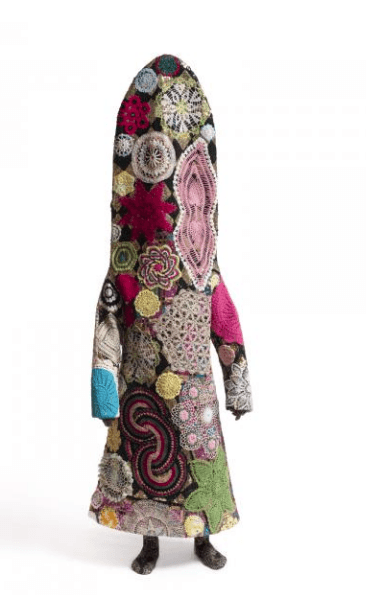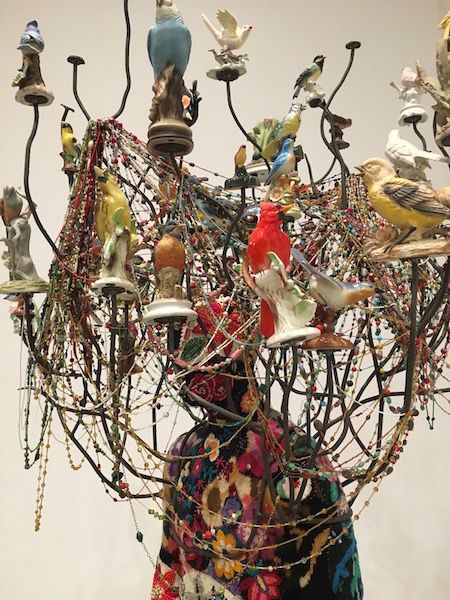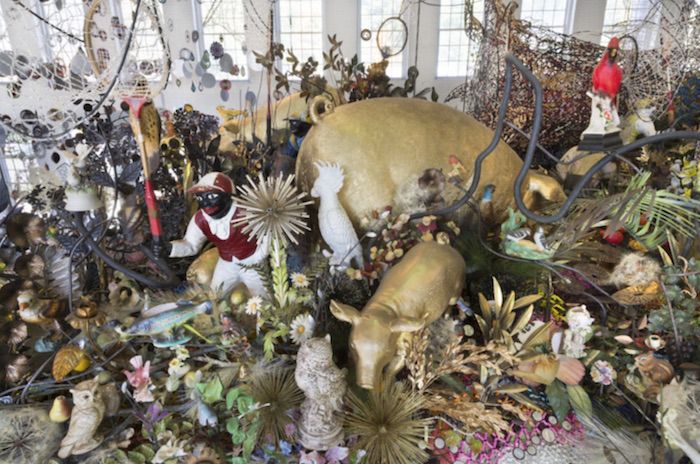
© Nick Cave, Soundsuit (detail), 2009, Smithsonian American Art Museum
Learning about Racism from Artist Nick Cave
Nick Cave is one of the most well-regarded visual artists in America today. His identity as a Black man deeply informs his art. He made his first sculptural costumes, called Soundsuits, in direct response to the 1992 beating of Rodney King. Now, in June 2020, I find myself reflecting on Cave’s messages about race as the world erupts in protest over police killings of people of color. His messages are as important as ever.
Nick Cave’s Soundsuits are protective and provocative
When I first saw Cave’s Soundsuits, I did not know their history. I was attracted to the vibrantly colored surfaces made of fabric and beads. They are richly embellished, sometimes shiny, sometimes warm and fuzzy.
But there was something about the shape of the costume that disturbed me. Many of his Soundsuits have a simple shape, which you could describe as a long dress. Instead of stopping at the neckline, the dress continues up to a pointy top, 2 or 3 feet above the wearer’s head. They are always displayed on manikins that tower over the viewer. They look like giant dolls with no eyes or facial features. You can’t make eye contact with the wearer; the costume is a barrier. The pointy hood makes me shudder. It reminds me of a Klansman’s hooded robe.

© Nick Cave, Soundsuit, 2009, Smithsonian American Art Museum
In a profile of Cave for T magazine (New York Times), Megan O’Grady wrote: “He initially conceived of [the Soundsuits] as a kind of race-, class- and gender-obscuring armature, one that’s both insulating and isolating, an articulation of his profound sense of vulnerability as a black man.” The Soundsuit was like a suit of armor that he could put on to protect himself from racial violence.
As O’Grady wrote, “Using costume to unsettle and dispel assumptions about identity is part of a long tradition of drag, from Elizabethan drama to Stonewall and beyond; at the same time, the suits are the perfect expression of W.E.B. Du Bois’s idea of double consciousness, the psychological adjustments black Americans make in order to survive within a white racist society, a vigilant, anticipatory awareness of the perceptions of others.”
The materials Cave uses for his Soundsuits have included everything from sisal to beads to sweater pieces to garden ornaments. In videos of Soundsuit performances that I’ve seen, the sound and sight of the sisal swishing as the performer moves is mesmerizing.

Detail of a Soundsuit (2009) on display at Institute of Contemporary Art Boston.
Nick Cave’s installation asks: Is there racism in heaven?
More recently Cave’s sculptures have exploded into massive installations, such as “Until,” displayed at MassMOCA several years ago. The provocative and probing title refers to the reality experienced by so man people of color: guilty until proven innocent. The lawn ornaments in this piece include statuettes of black-faced lawn jockeys. As Cave gathered kitschy figurines to use in this installation he kept coming upon these racist objects. As the exhibition notes explain, he reclaimed them to use as symbols of the narrative he wanted to tell, not the one the homeowners who put them in the yards intended. “Is there racism in heaven?” Cave asks in this installation.
Entering the football field-sized room where “Until” was installed, you walked through a sparkling mist of glittering spinning disks hanging from the ceiling. It’s a dazzling spectacle of movement and light.

Admiring the cloud of light-catching spinners dangling from the ceiling in Nick Cave’s installation Until at MassMOCA.
You emerge, as if from a dream, and look up at huge chandelier clouds hanging from the ceiling of the vast room. There were metal staircases to climb, and once you arrived at the top, you peered into the heavens. There you saw a chaotic collection of colorful figurines, beaded netting . . . and black-faced lawn jockeys.

Close-up of the heaven scene atop the chandeliers in Nick Cave’s installation Until at MassMOCA.
To learn more about this fascinating artist, listen to Nick Cave in this 14-minute video as he talks about art as a form of diplomacy, a way to communicate messages to change how people interact with one other.
Messages in my artwork
My bird sculptures explore the ways human behavior affects the land and impacts bird habitats. Read about the messages behind my works and see a gallery of my bird sculptures here.
Wonderful post, Eve! I too am an admirer of Cave’s work and his ability to engage viewers on numerous levels, certainly beyond their just their sense of sight. He is such a master of materials. I loved his comment that art is a form of diplomacy.
You’re right about him being a master of materials! He takes the most unlikely materials and transforms them.
Eve, he’s very interesting on Instagram. If you don’t already follow him, I would encourage you to check him out. Thanks for a great post about such a wonderful man/artist!
Yes!
Thanks, Eve. You have captured his message and essence so beautifully. I love his work, too. And among everything else, I admire that humor is also included along with his message.
Roz, I think Cave’s humor tricks the viewer into spending more time with his work. He approaches you like a friend so then you listen more closely.
Eve – Thanks for introducing me to Nick Cave, an incredible artist. His work is beautiful and imaginative yet disconcerting.
Ilene, I hope you’ll have a chance to see his work in person. The photos do not capture the whole feeling.